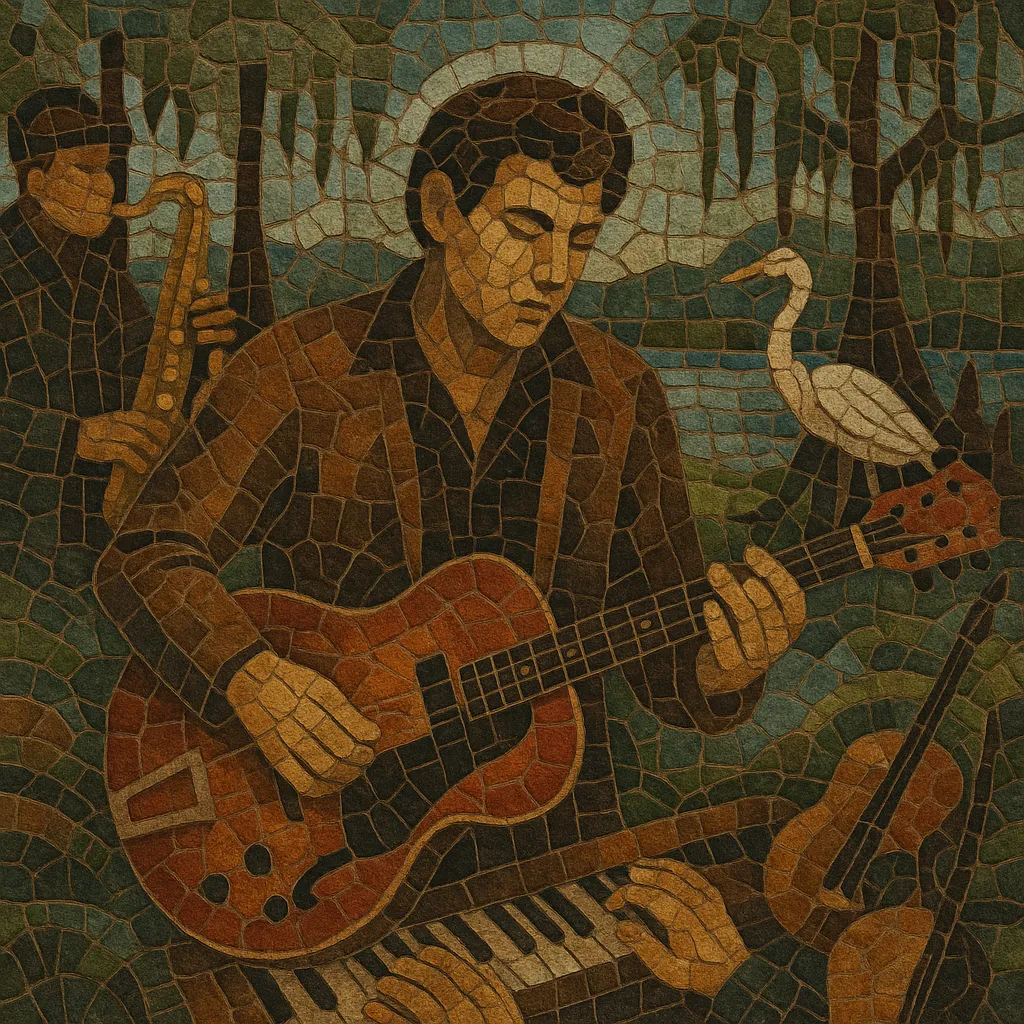Swamp pop is a romantic, dance‑hall oriented style from south Louisiana and southeast Texas that blends Cajun and Creole sensibilities with New Orleans rhythm & blues, early rock and roll, country balladry, and doo‑wop harmony.
Typically built on slow 12/8 or triplet feels, it features plaintive vocals, bittersweet melodies, and lush, echo‑laden production. Saxophone and piano lines intertwine with electric guitar, bass, and drums, while accordions or fiddles sometimes color the texture, reflecting local Cajun/Creole roots.
Lyrically it leans toward teenage heartbreak, longing, and late‑night nostalgia. The sound is both tender and danceable: slow‑dance ballads sit alongside shuffles and two‑steps that filled Gulf Coast roadhouses and parish dances.
Swamp pop emerged along the Gulf Coast—especially in south Louisiana and southeast Texas—when young Cajun and Creole musicians steeped in local dance music absorbed New Orleans R&B, early rock and roll, doo‑wop, and country ballads. Parish dances, roadhouses, and teen hops provided the crucible for this hybrid sound, and bilingual cultural life (English with Cajun/Creole French inflections) subtly shaped its phrasing and emotion.
Independent Gulf Coast labels and producers helped codify the style: Goldband (Eddie Shuler), Jin (Floyd Soileau), and later Huey P. Meaux’s operations in Texas. Landmark records such as Cookie and his Cupcakes’ “Mathilda” (1957/1959), Phil Phillips’ “Sea of Love” (1959), Rod Bernard’s “This Should Go On Forever” (1959), and Joe Barry’s “I’m A Fool To Care” (1961) defined swamp pop’s tender balladry and triplet‑based grooves.
As the style coalesced, local hits occasionally crossed over nationally. Dale & Grace’s “I’m Leaving It Up to You” (1963) exemplified swamp pop’s doo‑wop harmonies fused with Gulf Coast warmth. The core scene remained regional, centered on dance halls, live radio, and jukeboxes, where slow 12/8 ballads and mid‑tempo shuffles thrived.
The British Invasion and shifting pop tastes curtailed swamp pop’s national profile, but the genre persisted regionally. Artists like Johnnie Allan kept the flame (e.g., his 1971 Cajun‑rocking take on “Promised Land”). From the 1980s onward, reissue programs (e.g., Ace Records) and scholarship brought historical attention. Revivals and supergroups—such as Lil’ Band O’ Gold (with C.C. Adcock and Warren Storm)—reframed the sound for new audiences, while Gulf Coast festivals and events (later including the Ponderosa Stomp) celebrated its legacy.
Swamp pop’s heart‑tugging ballads and humid, echo‑soaked production informed later roots‑rock and Americana approaches, and provided a direct template for swamp rock’s grittier, guitar‑forward sound. Its cross‑cultural blend—Cajun/Creole dance music meeting New Orleans R&B and country—remains a signature Gulf Coast contribution to American popular music.
Use a classic Gulf Coast band setup: lead vocal, electric guitar, electric bass, drums, and piano, with tenor saxophone providing riffs and fills. Add accordion or occasional fiddle to nod to Cajun/Creole roots, and consider background vocals for doo‑wop‑style harmonies.
Center songs on slow 12/8 or triplet‑feel 4/4 grooves (think New Orleans R&B ballads). Drums should emphasize a gentle backbeat with brushed or lightly struck snare, and a swaying, danceable pocket. Include mid‑tempo shuffles and two‑steps for variety.
Rely on simple, emotive progressions (I–vi–IV–V, I–IV–V, or ii–V embellishments), often in major keys. Use verse–chorus forms, sometimes with a short bridge. Key changes up a whole step near the final chorus can heighten emotion.
Craft lyrical, singable melodies with a yearning quality. Lead vocals should be tender, slightly breathy or vibrato‑rich, with expressive slides and blue notes. Background harmonies echo doo‑wop or early pop styles.
Write about teenage heartbreak, longing, late‑night memories, small‑town romance, and dance‑hall encounters. Keep language direct and relatable, occasionally seasoning with regional imagery (bayous, rain, neon, Spanish moss).
Pursue a warm, humid ambiance: spring reverb on vocals and sax, tape echo or plate on guitar and piano, and a cohesive live‑room feel. Keep arrangements uncluttered, letting vocal emotion, sax fills, and piano triplets breathe.
Aim for intimacy; let the band breathe around the singer. Use dynamics: hushed verses, fuller choruses with horn swells or accordion pads. Endings can fade or conclude with a held vocal tag and gentle horn/piano cadence.


